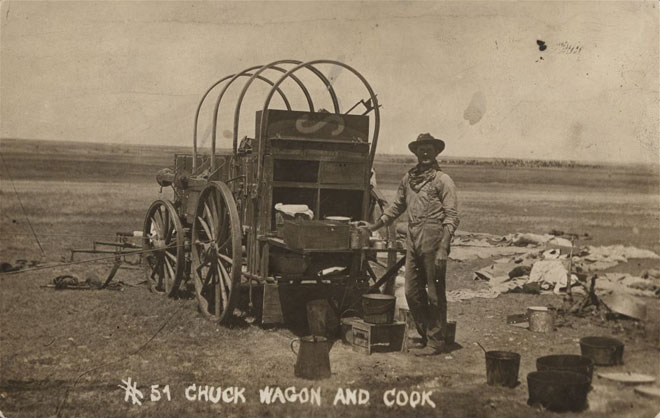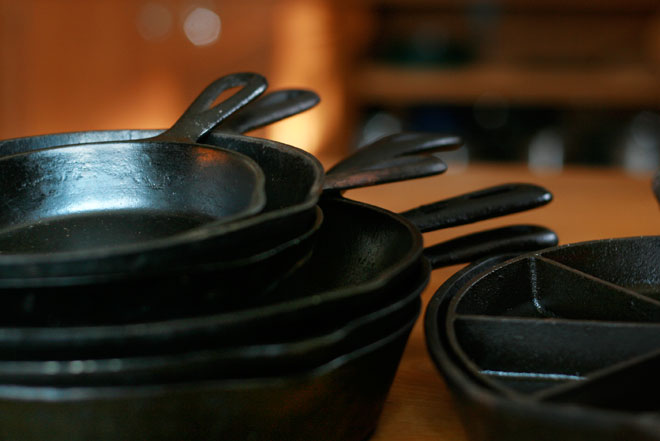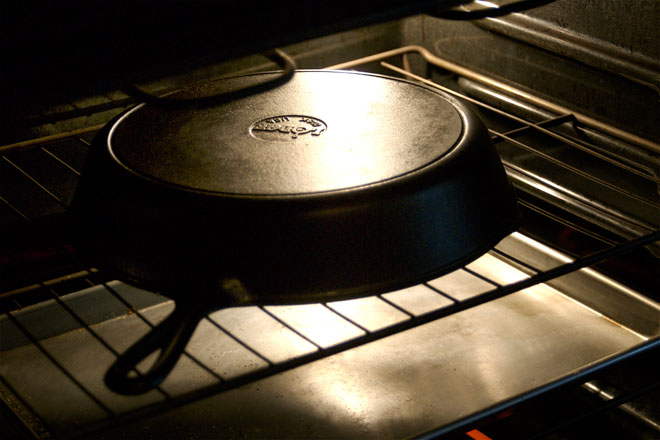There are some foods—scallops, a steak, pork chops—that cry out for a solid, gorgeous, homogeneous sear on the outside. Sure, you can get browning from a regular sauté pan. But let me speak plainly: Nothing cooks like cast iron.
Cast iron, you say? That heavy, slightly dirty-looking skillet your grandmother used? The skillets the pioneers took to the frontier? The same pan that Cowboys & Indians Magazine recently named one of its “Best of the West” icons, right there alongside the horse, the Bowie knife, and whiskey?
Like many things from the good ol’ days, cast iron is making a resurgence in today’s home and restaurant kitchens.

A postcard showing a cattle drive cook and a chuck wagon with an assortment of cast iron pots and pans. This photograph was taken in the vicinity of Liberal, Kansas, circa 1905. Image credit: Hal Reid / Kansas Historical Foundation.
The original non-stick pan, cast iron has a lot going for it: It’s cheap to buy new, easy to care for, incredibly long-lasting, and also it’s organic, not a chemical-based coating that has raised some questions about health concerns.
Something Old
Cast iron has been used for making cooking vessels since around 200 BC, during the Han Dynasty in China. Cast-iron skillets and Dutch ovens became ubiquitous in hearths the world wide until other cooking vessels made of lighter-weight steel, aluminum or other newly forged metals found their way into kitchens and cooking technology changed to stovetops and conventional ovens.
In early America, cast-iron cookware was a thriving industry, and family collections of the cookware were considered important enough they were deeded in wills and handed down generation by generation.
There is currently only one U.S.-based cast iron manufacturer: Lodge (more on that to come). For many cast-iron aficionados, though, it’s go old or go home empty-handed.
Greg Stahl founded the Wagner & Griswold Society in 1994 when his self-described addiction for cast iron made prior to the 1940s and especially goods made by the venerated (and alas, now-defunct) manufacturers Wagner and Griswold.

The Griswold logo on the bottom of a mid-20th century 9-inch square skillet. Image credit: Nic McPhee.
An endowed professor at Harvard Medical School, Stahl sounds positively delighted as he describes the difference between cookware made by hand versus machine (hand-poured iron is much smoother, making it easier to season, he says).
“I have a PhD. in physiology,” says Stahl. “I research for a living, so I started doing research on these things and I was hooked. I started with three skillets and today I’ve got hundreds of cast-iron items.”
Couple that research bent with a serious interest in gourmet cooking and it’s clear why Stahl bangs the cast-iron drum.
“To me, cooking with cast iron is all about the flavor,” he says. “If I have a choice, I’ll use cast iron. I couldn’t live without my Dutch oven and my skillet.”

Blueberry muffin skillet cake. Image credit: Chiot’s Run.
With more than 400 members from near and far (including Estonia and Australia), the Wagner & Griswold Society also has a forum for members to swap tips, tricks, questions and item descriptions.
“I have a couple of pieces made in the 1800s, and you just don’t know who has cooked with that,” Stahl says. “It could have been somebody famous, one of the pioneers. One of the amazing things about an antique skillet is that this piece is never going to be made again. It’s history.”
Something New
Opened in 1896 by Joseph Lodge in South Pittsburg, Tenn., Lodge is run by Joseph’s great-grandsons and is on the edge of an unprecedented growth spurt. Lodge PR Manager Mark Kelly said the fat hit the fire in 2002, when Lodge introduced pre-seasoned cast-iron cookware.
One drawback for many cooks is the seasoning involved with cast iron that makes it non-stick. Fresh from the box, cast iron is a bit of a sticky nightmare. But with patient seasoning – infusing the porous iron with vegetable oil until it becomes non-stick – the pot or pan can be an absolute joy to cook with. That process, though, has kept many first-time cast-iron buyers away.
Between the seasoned line of products and the then-new visibility to be got from the fledgling Food Network and the Internet, Lodge has seen such extensive growth that it’s planning a major expansion of its foundry that will increase production capacity by 40 percent to help it meet customer demand.
“People respect a company that’s been around for 100 years because they recognize that if you’ve been around that long, you must be doing something right,” Kelly says.
Basic Care and Feeding of Cast Iron
You have two basic choices when buying a cast-iron pot. You can buy one already seasoned, like Lodge’s, or you can season your own pan. If you buy an antique pan, you’ll probably want to clean it first (spray it with oven cleaner, wait 30 minutes, then wash in warm, soapy water and dry with paper towels, or use a lye soak, which is what Greg Stahl of the Wagner & Griswold Society does), and then re-season it.

Years of seasoning forms a rich patina on cast iron cookware. Image credit: Lee Davenport.
Post the question “How do I season a cast-iron pot?” online, and you’ll get a plethora of answers. I turned to the anal-retentive culinary experts at Cook’s Illustrated for their how-tos (published January 2011).
-
- Warm an unseasoned pan for 15 minutes in a 200-degree oven to open its pores.
- Remove the pan from the oven. Place 1 tablespoon flaxseed oil in the pan and, using tongs, rub the oil into the surface with paper towels. With fresh paper towels, thoroughly wipe out the pan to remove excess oil.
- Place the oiled pan upside down in a cold oven, then set the oven to its maximum baking temperature. Once the oven reaches its maximum temperature, heat the pan for one hour. Turn off the oven; cool the pan in the oven for at least two hours.
- Repeat the process five more times, or until the pan develops a dark, semi-matte surface.
Once it’s seasoned, the care of cast iron is fairly straightforward. I was introduced to cast iron by my husband, who had received a skillet from his father when he left home in the 1970s. One of our first fights as a married couple was when he walked in to the kitchen and found me diligently washing the pan with a scouring pad in hot, soapy water.

A Lodge skillet seasoning in an oven. Image credit: joellevand.
Most experts say warm water and a light scrub will do the trick. Others say there’s no need to wash the pans at all – just a rubdown with paper towels and a light coating of oil to retard rust. I confess that I rinse the pot under warm water and will give it a pass with the sponge for good measure.
Twenty-five years later, our most-used skillet (the 12-inch standby) has never shown a spot of rust or sticking, and it works like a charm.
For more information about cast-iron cookware, check out David Smith’s Web site, www.panman.com, including his comprehensive roster of sizes and volumes of Dutch ovens, skillets, oval roasters, and other pots and pans.
Check out these other kitchen essentials for preparing a meal.
 |
 |
 |
| Flame-Blackened Spatula | Flour Sifter | Large Stewing Spoon |
Laura Grimmer is a professional cook and sommelier who lives to eat, drink and provide sustenance. She came late to the culinary world, selling her PR firm and enrolling at the French Culinary Institute because of a borderline fixation on master chef Jacques Pépin. She left cooking school a classically trained chef with a deeply seated appreciation for tradition in the kitchen. www.perfectpairnyc.com.
